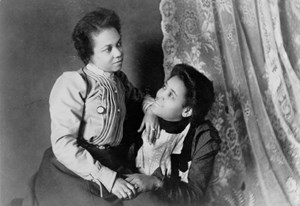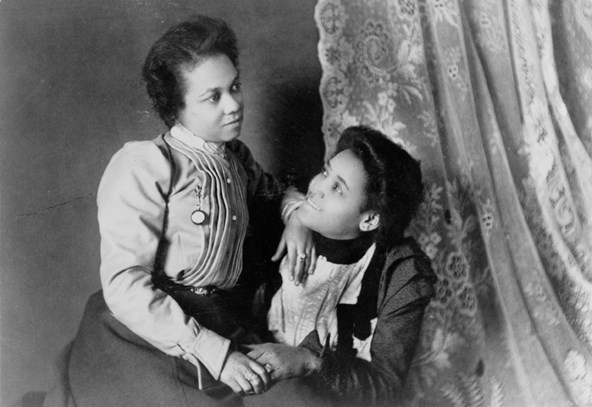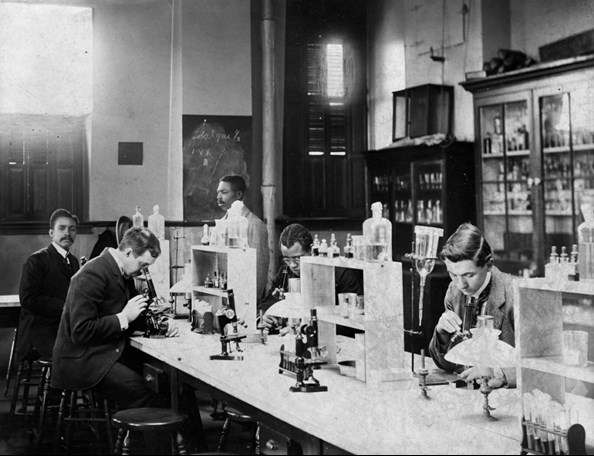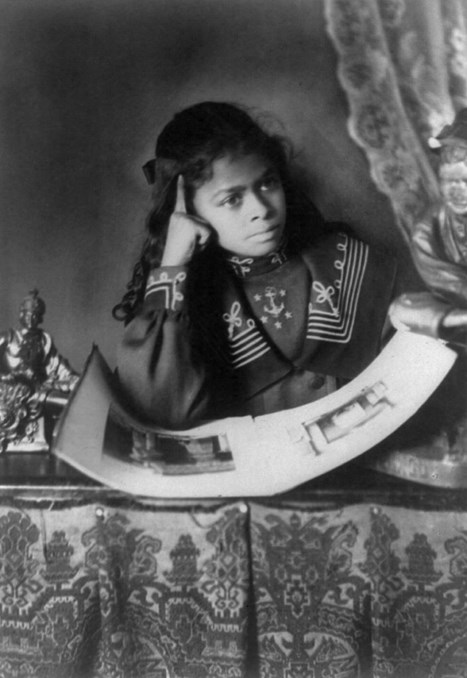
In an exhibit at the 1900 Paris Exposition, W.E.B. Du Bois presented a remarkable portrait of African American life. A selection of these photographs and data charts at the Museum invites visitors to critically engage with the visual dynamics of race.
Image: Two African American women, three-quarter length portrait, seated, facing each other (1899 or 1900), part of W. E. B. Du Bois’s albums of photographs exhibited at the Paris Exposition Universelle in 1900, v. 1, no. 48. Library of Congress Prints and Photographs Division.
In an exhibit at the 1900 Paris Exposition, W.E.B. Du Bois presented a remarkable portrait of African American life. A selection of these photographs and data charts at the Museum invites visitors to critically engage with the visual dynamics of race.
At the International Exposition of 1900 in Paris, American sociologist, historian, and civil rights activist W.E.B. Du Bois put together “The American Negro Exhibit,” a remarkable collection of more than 300 photographs of African-American men and women, homes, churches, businesses, and universities. These photographs were paired with a series of charts and graphs designed by Du Bois to visualize data about the descendants of former slaves in the United States. The exhibit directly challenged racist stereotypes and notions of racial segregation that were pervasive at the time. As part of this exhibit in Paris, Du Bois presented his prophetic and poetic statement, “The problem of the twentieth century is the problem of the color line”—a problem of the human condition that remains unresolved to this day.

Two African American women, three-quarter length portrait, seated, facing each other (1899 or 1900), part of W. E. B. Du Bois’s albums of photographs exhibited at the Paris Exposition Universelle in 1900, v. 1, no. 48. Library of Congress Prints and Photographs Division.
Combating these effects on a personal level, the photographs tell a story of beauty, strength, excellence, and—most poignantly of all—humanity. Collaborating with Booker T. Washington and Thomas Calloway, Du Bois chose images meant to showcase the presence, progress, and excellence of African Americans who, at the time, represented the first generation after slavery. Through his data visualizations, Du Bois used the striking visual language of bright colors and bold lines to convey the “color line” to a European audience. The exhibit won a gold medal at the Paris 1900 Exposition and is now part of the collection at the Library of Congress in Washington, D.C.

Howard Univ., Washington, D.C., ca. 1900 – class in bacteriology laboratory (ca. 1900), part of W. E. B. Du Bois albums of photographs exhibited at the Paris Exposition Universelle in 1900. Library of Congress Prints and Photographs Division.
This summer, a selection of these photographs and data charts from Du Bois’s “The American Negro Exhibit” will be reproduced and placed on view here at the Museum, along with a reading room space and additional resources. Developed by a project team of staff across departments including Alex Haynes, Rene Deras, Adam Garcia, John Goodwin, Grace Kook-Anderson, Ella Ray, Ted Smith, and Jeremiah Wyatt, Color Lineinvites visitors to critically engage with the visual dynamics of race at the moment of the 1900 Paris Exposition and beyond.

Thomas Askew, African American girl, half-length portrait, with right hand to cheek, with illustrated book on table (1899 or 1900), part of W. E. B. Du Bois’s albums of photographs exhibited at the Paris Exposition Universelle in 1900, v. 3, no. 210. Library of Congress Prints and Photographs Division.
“The main influence for this project is the humanity that lies within framing one’s own personal history,” remarks Alex Haynes, who works in the Museum’s Learning and Community Partnerships department and was a member of this exhibition’s project team. “After running into dead ends when researching my own family history, I began to increasingly value oral histories and photographs that came from my grandparents and family members. There’s something personal and beautiful to the way that Du Bois documented and showcased the excellence of the first generation of African Americans after slavery. My hope is to bring that narrative to the forefront and emphasize how much that display of culture and humanity still means, more than 100 years later.”

ArtDependence Magazine is an international magazine covering all spheres of contemporary art, as well as modern and classical art.
ArtDependence features the latest art news, highlighting interviews with today’s most influential artists, galleries, curators, collectors, fair directors and individuals at the axis of the arts.
The magazine also covers series of articles and reviews on critical art events, new publications and other foremost happenings in the art world.
If you would like to submit events or editorial content to ArtDependence Magazine, please feel free to reach the magazine via the contact page.